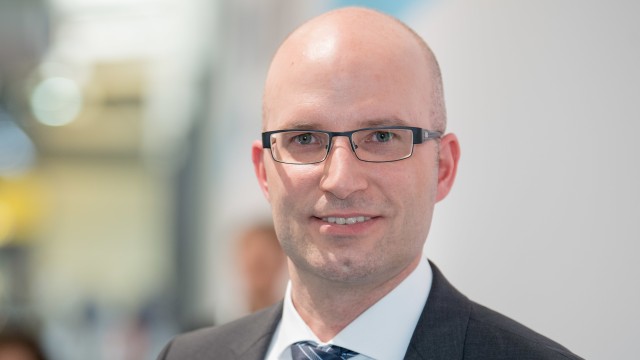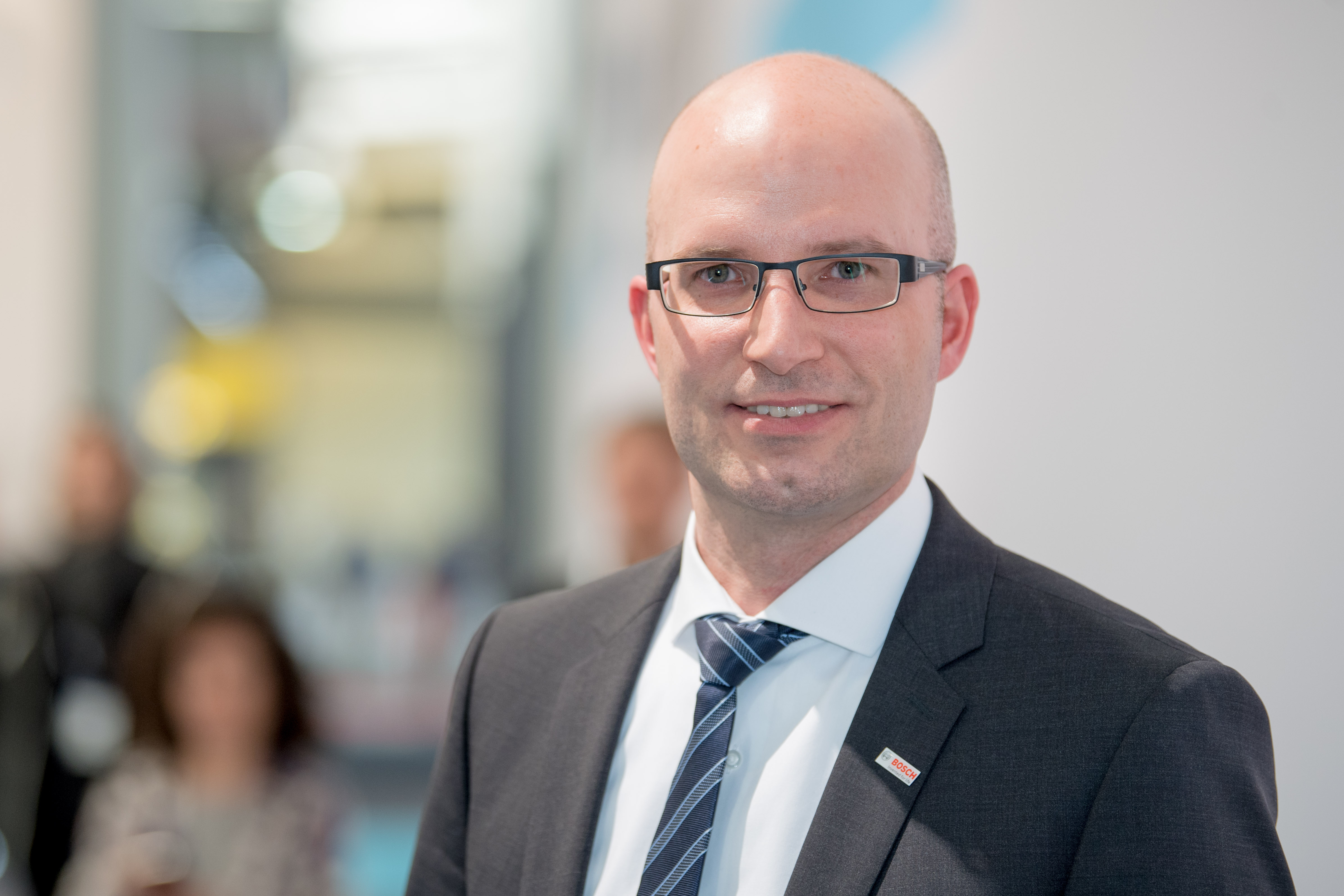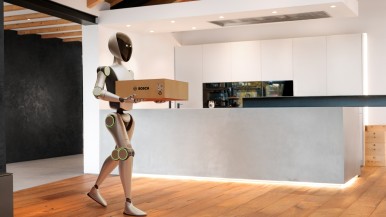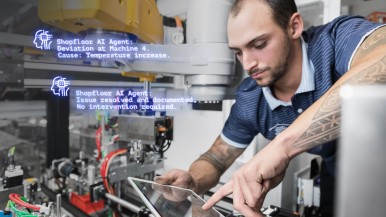How much better and faster will communication be with 5G?
Dr. Andreas Müller: We won’t only be faster and better, we’ll also cover a lot more. Striving for more is human nature, but it doesn’t always become reality. With 5G it’s different. 5G is a standard of superlatives: with top data rates of 20 gigabits a second, it is up to 20 times faster than 4G. It can transfer data virtually instantaneously with a latency of one millisecond, and is up to 99.9999 percent reliable – in other words, almost as safe as data transmission through a wire. 5G also makes wireless real-time “critical communication” possible for the first time. In other words, even applications that have to work absolutely reliably and securely can be realized wirelessly with 5G. This applies, for example, to a remotely operated crane as well as to a manufacturing facility. 5G opens up new areas of application in industry, where the performance of other wireless technologies such as Wi-Fi frequently fell short in the past.
How important is 5G for Bosch?
Dr. Andreas Müller: Bosch is an IoT company. We offer solutions for connected mobility, homes, and factories. All these are areas in which 5G will be used and deliver added value. In doing so, it has enormous disruptive potential: not only will it enable completely new technological solutions and business models, but it will also trigger fundamental changes to established value chains. Bosch launched its research activities in 5G as early as 2014 and got involved with a host of national and international initiatives and bodies. One of these is the 5G Alliance for Connected Industries and Automation (5G-ACIA), which has more than 70 companies and research institutions as members. Bosch has taken on the chair of the alliance to work with partners in shaping 5G so that it meets the needs of industry from the outset. In addition, we applied to Germany’s Federal Network Agency for 5G licenses for selected German locations and received them.
Here, Germany is blazing a path for the rest of the world in making it possible for companies to set up their own local campus networks. This also offers opportunities for leveraging the full potential of Industry 4.0, particularly in the manufacturing sector. Such opportunities are especially important for Bosch, As the company believes Industry 4.0 is the way forward, and is digitalizing its plants and those of its customers.
What benefits does 5G offer manufacturing? Can you name some examples?
Dr. Andreas Müller: 5G will become the central nervous system of the factory of the future. The new communications standard will make manufacturing more flexible, more mobile, and more productive. One way to use 5G in manufacturing is with portable, mobile operating panels, which on-site workers can use to plug into various systems and machines. The panels themselves can also support safety-critical applications like kill switches. At the moment, such mechanisms are usually stationary and attached to each separate machine. 5G reduces that number and simultaneously improves working conditions for associates, who can quickly and conveniently access the machines. Augmented reality in conjunction with the new mobile communications standard will also deliver considerable benefits. For instance, workers wearing data glasses connected via 5G can access additional information in their field of vision in real time, optimizing how they monitor and maintain machinery. 5G also makes it possible to link driverless transport systems and integrate them into manufacturing operations without any difficulty. We presented ActiveShuttle, an initial prototype for a 5G-capable transport system, at the Hannover Messe 2019.
What role exactly does 5G play in ActiveShuttle?
Dr. Andreas Müller: In the first stage, we’ve replaced “only” the current Wi-Fi connection with 5G. That has already brought many advantages, such as a more stable connection and the avoidance of interruptions to communication when switching between different wireless access nodes. But things should really get interesting when we launch the second stage. At that point, we will shift the “intelligence” of our transport system, meaning key control functions, to a local cloud and use 5G for data transfer between the machine and IT infrastructure. This will pave the way for more affordable devices, and improve maintenance, safety, security, and scalability. At the same time, we’ll be able to realize new functions relatively easily, such as cooperative maneuvers between different transport systems. What we’re currently looking into is these sorts of approaches, which weren’t possible before 5G. The first prototypes will be available in the next few months. Often it’s the way they combine the trio of 5G, edge computing, and AI that’s truly revolutionary.
If 5G gives production a boost, why has Bosch applied for 5G licenses for only its two locations in Feuerbach and Renningen?
Dr. Andreas Müller: We’re still in the process of evaluating 5G’s full potential and working out new manufacturing concepts. This takes time and will happen first at selected locations that do pioneering work for the entire Bosch network.. However, we have firm plans to eventually roll out 5G to all Bosch plants step by step. There are already 5G activities underway at several locations, although still using test licenses from the network agency.
What were the criteria for selecting the Feuerbach and Renningen locations?
Dr. Andreas Müller: Various factors come together at these locations. The plant in Feuerbach is one of Bosch’s largest factories in Germany and very centrally located, with the research campus in Renningen, Bosch Rexroth branches, corporate IT, and the Bosch Connected Industry operating unit all very close by. We can bring together various kinds of expertise and professionals relatively easily and quickly – which is precisely what we need. What’s more, Feuerbach is a lead plant for Industry 4.0 at Bosch and now also a lead plant for 5G. The research campus in Renningen, is the nucleus of research and development at Bosch. That’s where we ran early tests on 5G and its application in an industrial setting. Our plan is to expand that further and gradually extend those activities to other domains, such as agriculture or building automation.
You have put the first 5G campus network into operation in Feuerbach. What was the biggest challenge?
Dr. Andreas Müller: 5G campus networks are uncharted territory – for Bosch as well as for everyone else. These challenges start at the network planning stage. Traditional network planning generally focuses on network coverage and the feasible data transfer rate. In a factory, however, criteria such as latency and reliability also play a role. Guaranteeing 99.9999% reliability is not so easy from a planning perspective. Beyond that, questions about topology arose – how exactly the network is going to be constructed. Working out the details of how to integrate it securely into existing structures, for example the existing Bosch network, was also very challenging
Who is Bosch working with to set up these 5G networks?
Dr. Andreas Müller: We select our partners on a project-related basis. In the current phase it is also important to get to know the offers of different providers even better. At the Stuttgart-Feuerbach plant, for example, we have implemented the network construction with Nokia. While Bosch defined use cases, Nokia supplied the 5G infrastructure components. Both companies carried out the network planning together. At our semiconductor plant in Reutlingen however, we are working together with Ericsson as part of the 5G-SMART research project. The aim of this project is to evaluate the effects of 5G on the extremely complex and sensitive semiconductor manufacturing process.
Aside from 5G-capable factories, there are also machines and products that have to be compatible with the new standard. Bosch recently launched a new 5G-capable control technology. Will Bosch be making all its products 5G-capable?
Dr. Andreas Müller: Bosch Rexroth’s new control technology, ctrlX AUTOMATION, is a true revolution. ctrlX AUTOMATION bridges the gap between control systems, IT, and the internet of things, and was designed with 5G in mind. 5G will be making its way not only into manufacturing, but also into domains such as agriculture, urban development, and healthcare. As a result, we are constantly assessing whether using 5G makes sense or if another technology might not be a better choice. 5G is not an end in itself, but should always offer recognizable added value for our customers.
How does 5G affect people’s health? How dangerous is the radiation exposure from 5G?
Dr. Andreas Müller: Bosch takes this topic very seriously, as well as the concerns that people sometimes have about it. Complying with all legal requirements and threshold values is a given. In addition, we regularly analyze the assessments and recommendations from various organizations, such as the World Health Organization (WHO) and the German Federal Office for Radiation Protection (BfS). Neither WHO nor BfS have so far found any scientific evidence of negative effects on people’s health, despite numerous studies. Apart from that, we are drawing up concepts that would minimize radiation exposure, for instance through proper network planning. A high density of base stations is actually a good thing, since this can markedly reduce the transmission power. But ultimately it’s always about the terminal device’s reception quality. In plants, the transmission power of 5G will be comparable to that of Wi-Fi.
What will 5G change for Bosch associates?
Dr. Andreas Müller: With 5G, we’ll be making entirely new manufacturing concepts a reality, moving us toward our vision of the factory of the future. This of course goes hand in hand with giving our associates training. The new mobile communications standard has the potential to simplify and improve the work our associates do in manufacturing and logistics. And that’s the whole point.






